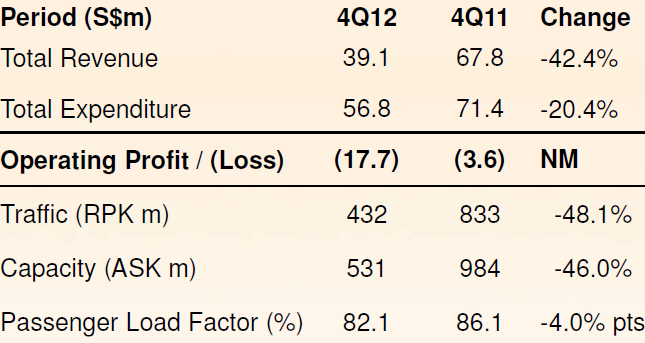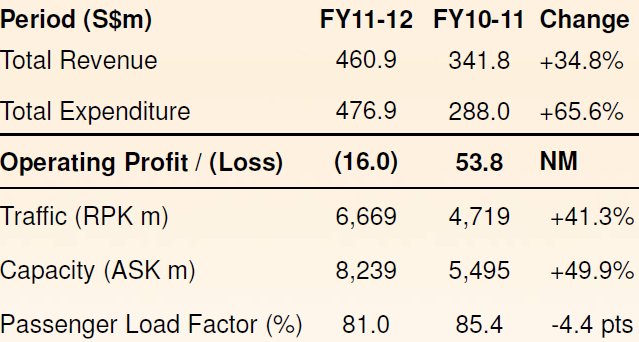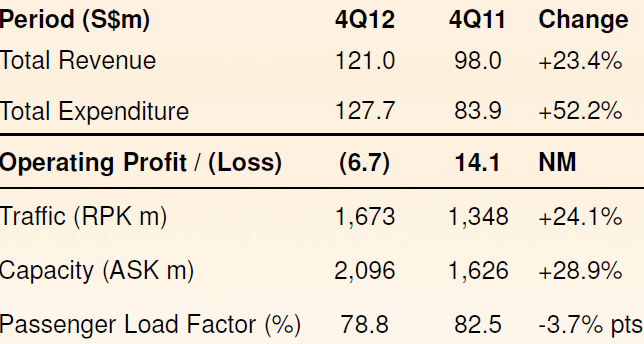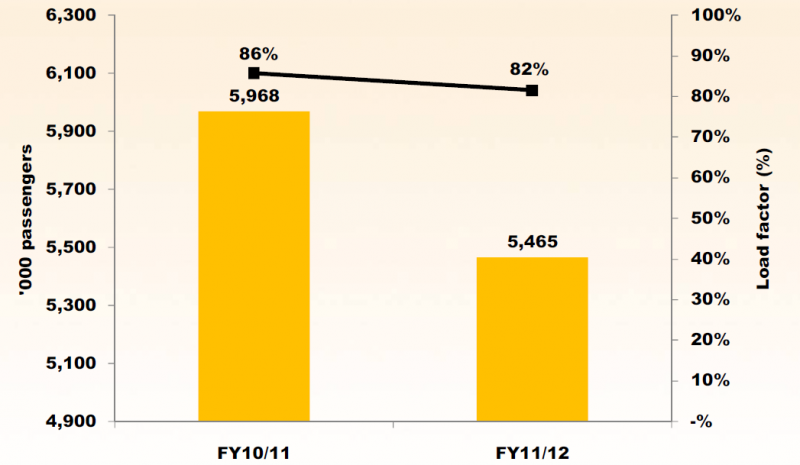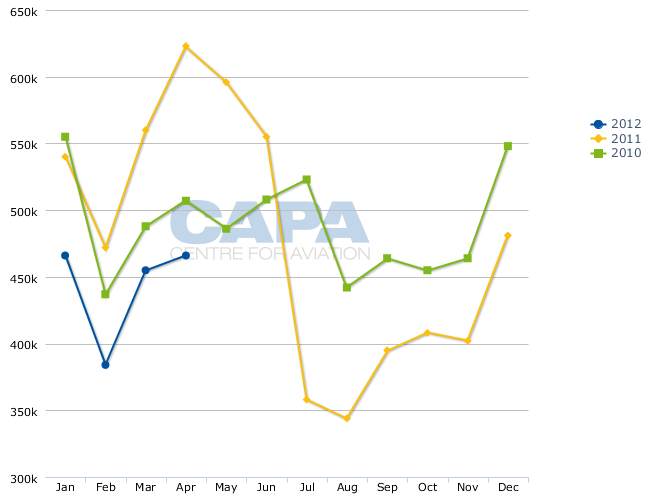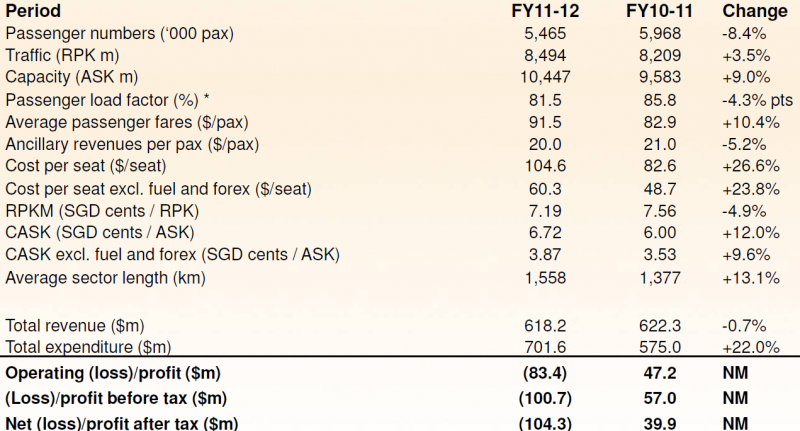Tiger faces challenging year as it looks to recover following losses in Australia and Singapore
Tiger Airways has reported a loss of SGD104 million (USD82 million) for its fiscal year ending 31-Mar-2012, a rare negative result for a leading Asian LCC, which generally continues to profit from the huge growth opportunities in the budget end of Asia's dynamic market. But Tiger is confident the launch of new joint ventures in Indonesia and the Philippines will allow the group to absorb the excess capacity which plagued Tiger in FY2011/12, significantly increasing its ex-fuel unit costs as its fleet became underutilised.
With the return of higher aircraft utilisation and lower unit costs, coupled with more rationale capacity, Tiger's typically profitable Singapore operation could return to the black later this year. But turning around the Australia operation, which was already unprofitable prior to the six-week grounding by Australian regulators last July and August, could be more challenging. Equally daunting is the task of turning its newly launched joint venture in Indonesia and its planned joint venture in the Philippines, which is now expected to launch in the quarter ending 30-Sep-2012 (2QFY2012/13), into profitable investments.
- Tiger Airways reported a loss of SGD104 million (USD82 million) for the fiscal year ending 31-Mar-2012, due to excess capacity and underutilization of its fleet.
- The launch of new joint ventures in Indonesia and the Philippines is expected to help absorb the excess capacity and increase profitability.
- Tiger Airways faces challenges in turning around its unprofitable operations in Australia and Singapore.
- The Indonesian and Philippine markets offer growth opportunities, but Tiger Airways faces intense competition from other LCCs in these markets.
- Tiger Airways plans to double its fleet to 68 aircraft by the end of 2015, but it needs successful joint ventures to absorb the additional capacity.
- The success of the joint ventures in Indonesia and the Philippines is crucial for Tiger Airways to fulfill its commitments to Airbus and become a pan-Asian group.
The Indonesian and Philippine markets have tremendous growth opportunities that go way beyond the opportunities in Tiger's much smaller home market of Singapore. But Tiger had first mover advantage in Singapore while in Indonesia and the Philippines it becomes the fourth or fifth LCC. Both markets will almost certainly see consolidation in the short to medium term. As the newcomer Tiger and its partners - Mandala in Indonesia and SEAir in the Philippines - could be forced to trade profitability for market share, a typical but generally unsustainable recipe.
In the long term, Tiger will need more than Singapore to secure its future. The group is committed to doubling its fleet to 68 aircraft by the end of 2015 but recent lessons in Singapore have proven the Singapore market can only support a fleet of about 20 aircraft and relatively modest growth. Tiger has fallen badly behind rival LCC groups AirAsia and Jetstar, both of which are now racing into the promising North Asia market this year as Tiger finally starts to build its footprint in Southeast Asia.
North Asia, where LCCs currently account for less than 10% of intra-regional capacity, clearly presents the biggest opportunities for Asia's LCCs. While still growing on the back of continued economic growth and an expanding middle class, Southeast Asia has matured in that LCCs have already captured about 50% of the intra-regional market. Tiger may quickly discover it joined the party in Indonesia and the Philippines too late and that even its base in Singapore, where it faces intense competition from Jetstar and AirAsia, could be vulnerable.
Tiger blamed its "disappointing" performance for FY2011/12 on the suspension of operations in Australia and the subsequent underutilisation of its group fleet as well as on high fuel prices. The SGD104 million (USD82 million) net loss for the year represents a SGD144 million (USD113 million) turn from the net profit of SGD40 million (USD31 million) in FY2010/11.
Tiger has now been in the red for three consecutive quarters including in the most recent 4QFY2011/12, when it incurred a net loss of SGD16 million (USD13 million) compared to a SGD1 million (USD1 million) profit for 4QFY2010/11. Prior to the current string of losses, Tiger had been profitable in several consecutive quarters, dating back to before its Jan-2010 initial public offering.
Aircraft underutilisation hurts Tiger in both Australia and Singapore
Underutilisation continues to be a problem at the Group's Australia subsidiary as the carrier has been slow to rebuild its network following its resumption of services in Aug-2011. While Tiger has been quick to say underutilisation was a result of conditions imposed by Australia's regulator, the Civil Aviation Safety Authority, that was only true for the month after Tiger resumed services. Afterwards Tiger was free to apply for additional frequencies at its leisure and has never been declined an increase. Tiger requested increases prior to announcing its results for 4QFY2011/12, allowing the Group to announce some good news with the financial losses.
Tiger Australia ended FY2011/12 with an operating loss of SGD77 million (USD61 million), compared to a loss of SGD9 million (USD7 million) loss in FY2010/11. Tiger Australia was in the red every quarter last year, including a SGD18 million (USD14 million) operating loss for 4Q2011/12.
Tiger Australia financial highlights: FY2011/12 vs FY2010/11
Tiger Australia financial highlights: 4QFY2011/12 vs 4QFY2010/11
Tiger Singapore also ended FY2011/12 in the red as a 47% increase in seat capacity proved to be too aggressive. The carrier incurred an operating loss of SGD16 million (USD13 million) for the fiscal year, compared to a record operating profit of SGD54 million (USD43 million) for FY2010/11 and an operating profit of SGD24 million (USD19 million) in FY2009/10. Tiger Singapore has now incurred losses in three consecutive quarters, including a SGD7 million (USD6 million) operating loss in 4Q2011/12, which compared to a SGD14 million (USD11 million) operating profit in 4Q2010/11.
Tiger Singapore financial highlights: FY2011/12 vs FY2010/11
Tiger Singapore financial highlights: 4QFY2011/12 vs 4QFY2010/11
Tiger was forced to allocate to Singapore all of its additional capacity in FY2011/12 due to the grounding in Australia, where plans to expand the fleet had to be postponed, and the failure to launch new joint ventures in other markets. In the second half of calendar 2012, it became clear the capacity could not be absorbed by the Singapore market as the carrier's load factors started to fall (Jetstar Asia, however, did see its capacity be absorbed). Tiger responded by slowing down the growth but that resulted in lower aircraft utilisation, which in turn impacted profitability as unit costs increased.
Tiger Airways Group CEO Chin Yau Seng is now confident the situation in Singapore will improve in FY2012/13 as the size of the Singapore fleet reduces in size, allowing the carrier to improve utilisation while offering capacity that more closely matches demand. Tiger Singapore now has 21 A320s, which Mr Chin says still represents an excess of two aircraft given the carrier's current schedule. But two A320s are due to be returned at the expiration of their leases over the next couple of months, giving Tiger Singapore an optimum fleet of 19 A320s.
Tiger Singapore now plans to offer in the current Northern Hemisphere summer season only 7% more seat capacity than summer 2011. Mr Chin believes the relatively modest growth will allow all the capacity added last year to finally be absorbed, resulting in an improvement in Tiger Singapore's performance. "We think that Tiger Singapore is on track to get to that point where capacity is well matched to demand," he says. "We are quietly confident on that front."
Tiger Singapore is not revealing how much capacity it expects to offer for fiscal FY2012/13, saying it still has some flexibility to adjust capacity in response to market conditions. But given that current capacity is below capacity levels of late FY2011/2012 it would not be surprising to see an overall decrease in capacity for Tiger Singapore in FY2012/13, especially as Tiger Singapore is intending to keep its fleet at only 19 aircraft for the rest of this year.
Tiger Australia resumes expansion
Tiger Australia currently has the equivalent of three excess A320s in its 10-aircraft fleet. But the carrier, which has been significantly underutilising its aircraft due to agreeing to operate 64 daily sectors, plans to increase utilisation over the next few months to pre-grounding levels. Mr Chin says a second base in Sydney will open in Jul-2012 and once fully up and running will absorb the three excess aircraft. Tiger Australia also is slated to take an 11th A320 in Sep-2012, allowing for capacity expansion.
Mr Chin is confident Tiger Australia will be in position in the second half of the year to potentially be profitable because the carrier will have higher utilisation and therefore lower unit costs. As a group, Tiger saw its unit costs excluding fuel and foreign exchange increase 10% in FY2011/12 due to the lower utilisation of its fleet in both Australia and Singapore. Mr Chin expects Tiger's ex-fuel unit costs to return to normal levels in the second half the year. This is key as the higher unit costs are currently putting Tiger at a disadvantage compared to its LCC competitors, making it very difficult to be profitable particularly given the high price of fuel.
Tiger's costs overall soared by 22% in FY2011/12 to SGD702 million (USD553 million). But the Group's revenues decreased by 1% to SGD618 million (USD487 million). Higher fuel costs accounted for just over half of the increase in total expenditures, indicating Tiger's costs challenges were not limited to fuel.
ASKs for the group were up by 9% in FY2011/12 while RPKs only increased by 4%. As a result, Tiger's load factor slipped by 4.3 ppts to 81.5%. The load factors in Singapore and Australia last year were nearly identical although the drop in Australia was more pronounced, slipping about 6 ppts compared to a drop of about 4 ppts in Singapore.
Tiger Airways Group load factor and passenger traffic: FY2011/12 vs FY2010/11
Passenger numbers were down 8% for the year to 5.5 million - an unusual trend for an Asian LCC. Year-over-year traffic at the Group has been down every month since the grounding of the Australia operation in Jul-2011.
Tiger Airways Group monthly traffic: Jan-2010 to Apr-2012
Average fares were up 10% to SGD91.5 (USD72.0) per passenger but this was not sufficient to offset the higher fuel costs let alone the drop in load factor (see Background information). Tiger also saw a hit in ancillary revenues per passenger, which dropped 5% to SGD20.0 (USD15.7). The Group expects its ancillaries will recover as its Australian operation, which sees higher average ancillaries than the Singapore operation, rebuilds. Tiger executives point out that ancillaries per passenger were flat in 4QFY2011/12 while average fares were up 22%, providing an encouraging sign for the new fiscal year.
But Tiger's traffic figures for Apr-2012, the first month of its new fiscal year, did not show signs of improvement. The Group's load factor for Apr-2012 was 80%, down 8 ppts compared to Apr-2011.
While Tiger is confident in an improvement in the performance at Tiger Australia and Tiger Singapore, the Group is also banking on quick success for its new joint ventures in Indonesia and the Philippines. Both joint ventures are particularly needed to soak up the aircraft Tiger has on order for this year and next year. If either new affiliate fails, Tiger will quickly find itself again with too many aircraft.
Tiger encouraged by Mandala's initial performance
Mandala resumed services in Apr-2012 with three A320s from Tiger. Mr Chin says "it is early days" but so far "the load factors are encouraging".
Tiger has a 33% stake in the new Mandala, which had been grounded since early 2011 after suspending operations and filing for bankruptcy. Tiger previously said Mandala would soak up all the additional A320s the Group is committed to adding this year except for the one additional aircraft for the Australian operation, resulting in a fleet at the Indonesian carrier of 10 A320s by the end of FY2012/13. Mr Chin says this has been adjusted slightly and Mandala is now slated to end the current fiscal year with seven A320s. But he says three more A320s will be delivered to Mandala early in FY2013/14, ensuring Mandala meets an Indonesian regulatory requirement to have a fleet of 10 aircraft within its first year of operations.
Mr Chin says Mandala will continue to operate its current of fleet of three A320s, which are being used on Jakarta-Medan, Medan-Singapore and Jakarta-Kuala Lumpur routes, for the next few months. He says all four of Mandala's additional A320s for the current fiscal year are slated for delivery in the 2HFY2012/13. Mandala is currently preparing for the next phase of its network expansion with route announcements expected over the next several weeks.
See related articles:
- Tiger-backed Mandala resumes operations with focus on Indonesia's largest routes
- Tiger places big bet on Indonesia with re-launch of Mandala
Tiger closes in on Philippine joint venture
Meanwhile, Tiger continues to negotiate to acquire a stake in Philippine carrier SEAir and is now optimistic a deal will conclude in 2QFY2012/13. Tiger is confident enough in the status of the talks to allocate three A320s from its FY2012/13 deliveries for SEAir (a few months ago these aircraft had been allocated for Mandala). Mr Chin says these aircraft are slated for delivery by the end of Dec-2012, giving the Tiger-SEAir joint venture a fleet of five A320 family aircraft.
SEAir has been operating two Tiger A319s on international routes from Clark Airport outside Manila since late 2010 under a marketing tie-up. The two carriers have since been negotiating a joint venture, which initially envisioned Tiger taking a 33% stake in SEAir. In Apr-2012 Tiger announced a revision and extension of the original term sheet signed by the two companies and that Tiger was now intending to acquire a 40% stake in SEAir for USD7 million. The A319s, which SEAir now leases from Tiger, will be brought into the joint venture while A320s will be added.
In addition to the two A319s in the international market, SEAir also operates a fleet of small turboprops on regional domestic routes. But this operation will be split off and not be part of the deal with Tiger. The proposed SEAir-Tiger joint venture envisions expanding the current A319 international operation as well as launching services on domestic trunk routes.
Challenges remain in the Philippines and Indonesia
While it appears Tiger is finally on course to launch its joint venture in the Philippines, it cannot breathe easily just yet. The Philippine market has become extremely crowded with LCCs following the launch earlier this year of AirAsia Philippines (also in the market is leader Cebu Pacific, Philippine Airlines LCC sister company AirPhil Express and Zest Airways).
All of the existing Philippine LCCs are planning rapid expansion. With Cebu Pacific the only profitable carrier in the Philippine LCC sector, consolidation in the sector is likely. As the smallest of the Philippine LCCs, the Tiger-SEAir joint venture could face challenges.
Indonesia is a bigger market but is also extremely competitive. Mandala is now competing against three much larger LCCs: market leader Lion Air, Garuda budget unit Citilink and Indonesia AirAsia. Several of Indonesia's other carriers - such as Batavia Air and Sriwijaya Air - are also low fare players although they are generally not considered LCCs.
Tiger, which is committed to expanding its A320 fleet to 68 aircraft by the end of 2015, is banking on the Mandala and SEAir projects succeeding. If there are failures, Tiger will find itself in the difficult position of having to cancel or defer orders or lease out aircraft.
In addition to accounting for all but one of the A320s being added to the group fleet in FY2012/13, Mr Chin says Mandala and SEAir will again be called on to absorb the 10 A320s being added to the fleet in FY2013/14. "We are banking on the investment being completed in the Philippines," he says.
See related articles:
- Tiger Airways' pan-Asian ambitions floundering with dire need for growth
- Tiger Airways looks to catch up after rights issue and departure of founding CEO Tony Davis
- Tiger Airways records pre-grounding loss; outlook darkens as new JVs face delays
Outlook: Tiger has long road ahead
Tiger has an unenviable track record in building its portfolio of carriers. Prior failures in completing planned joint ventures in South Korea and Thailand have left Tiger way behind rivals AirAsia and Jetstar. In fact, Tiger is so behind it is no longer in the race to become the leading LCC group in Asia Pacific. AirAsia and Jetstar have made it a two-horse race with both groups moving the competition this year to North Asia, where there are tremendous growth opportunities. While North Asia opportunities would appeal to Tiger, it will likely struggle to enter this important market given its recent challenges and weak position as a group compared to AirAsia and Jetstar.
The new fiscal year could prove to be a do-or-die year for Tiger. Rapid success in Indonesia and the Philippines is crucial for Tiger to fulfil its commitments to Airbus and if it is to succeed in its original mission to become a pan-Asian group. The financial losses should the Mandala and SEAir investments not work out could also be tough to overcome.
Tiger will also need this year to quickly turn around its existing operations in Australia and Singapore. With AirAsia and Jetstar breathing down Tiger's neck in Singapore, Tiger Singapore cannot afford to make another misstep. AirAsia and Jetstar both have large operations in Singapore, which account for a similar amount of capacity at Changi Airport as Tiger Singapore, and are better positioned financially to weather any storms. In Australia, Tiger still has to overcome its tarnished image and stiff competition from much bigger Jetstar.
All these challenges will be inherited by Tiger's new CEO as Mr Chin has decided to return to Singapore Airlines, where he took a temporary leave of absence to help orchestrate an attempted turnaround at Tiger following the departure of the Tiger founding CEO Tony Davis. Mr Chin, who has agreed to stay on until the search for his successor (which began in Feb-2012) can be completed, will leave a turnaround job which is still very much a work in progress.
Conversion rate: USD1 = SGD1.27
Background information
Tiger Airways Group financial and operational highlights: FY2011/12 vs FY2010/11
Tiger Airways Group financial and operational highlights: 4QFY2011/12 vs 4QFY2010/11

